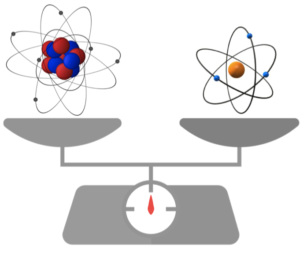The following are common mass-related terminologies that students encounter when they study Chemistry:-
Relative isotopic mass
The relative isotopic mass is the ratio of the mass of an isotope in unified atomic mass unit to one unified atomic mass unit. It is a dimensionless quantity, for example, the relative isotopic mass of 1H is 1.007825.

Relative atomic mass
The relative atomic mass of an element is the weighted average of the relative isotopic masses of all its isotopes. It is represented by the symbol Ar and is the value usually found next to the symbol of an element in a periodic table. For example, the relative atomic mass of copper, Ar(Cu), is (62.929601 x 0.6917) + (64.927794 x 0.3083) ≈ 63.546.
| Relative isotopic mass | % Abundance | |
| 63Cu | 62.929601 | 69.17 |
| 65Cu | 64.927794 | 30.83 |
The terms ‘atomic weight’ and ‘standard atomic weight’ are sometimes used in place of relative atomic mass. Strictly speaking, standard atomic weight is only equivalent to relative atomic mass when studying the masses of elements on earth.
Relative molecular mass
The relative molecular mass of a covalent bonded molecule is the sum of the relative atomic masses of all atoms making up the molecule. It is represented by the symbol Mr . For example, the relative molecular mass of carbon dioxide, Mr(CO2), is 12.011 + (15.999 x 2) = 44.009.
| Relative atomic mass | |
| C | 12.011 |
| O | 15.999 |
For an ionic compound, the term relative formula mass is used instead of relative molecular mass.
Atomic mass
The mass of an atom (i.e. the mass of an isotope and not an average mass of all isotopes of an element). It is defined in unified atomic mass unit, u, and can be converted to the basic SI mass unit, kg. When the atomic mass of an isotope is stated in u, it has exactly the same numerical value as the isotope’s relative isotopic mass. For example,
| Relative isotopic mass | Atomic mass, u | Atomic mass, kg | |
| 2H | 2.014104 | 2.014104 | 3.34450 x 10-27 |
The relationship between the unified atomic mass unit, u, and the basic SI mass unit, kg, is:
where is NA is the Avogadro constant. The value 0.001 kgmol-1 is called the molar mass constant and is usually written as 1 gmol-1. With the new definition of the Avogadro constant as exactly 6.02214076 x 1023 mol-1, the value of the molar mass constant deviates very slightly from the exact value of 1 gmol-1 and has to be determined through future experiments.
Molecular mass
The molecular mass is the mass of a molecule. It is defined in unified atomic mass unit, u, and can be converted to the basic SI mass unit, kg. Since an atom in a molecule is a specific isotope of an element, different molecules of the same compound may have different molecular mass. For example, the molecular mass of nitrogen gas can be
| Molecular mass, u | |
| 14N14N | 14.003074 + 14.003074 = 28.006148 |
| 14N15N | 14.003074 + 15.000109 = 29.003183 |
| 15N15N | 15.000109 + 15.000109 = 30.000218 |
For ionic compounds, the term formula mass is used instead of molecular mass.
Molar mass
The molar mass of a substance is the mass of the substance per mole. It is represented by the symbol M and has the SI unit of kgmol-1. However, most molar masses are expressed in gmol-1 for practical purpose. For an isotope, it is its atomic mass in gmol-1. For an element, it is its average atomic mass in gmol-1. For a covalent and an ionic compound, it is the average molecular mass in gmol-1 and average formula mass in gmol-1 respectively. For example,
| M, gmol-1 | |
| 35Cl | 34.97 |
| Cl | 35.45 |
| N2 | 28.014 |
| CuSO4 | 159.602 |


